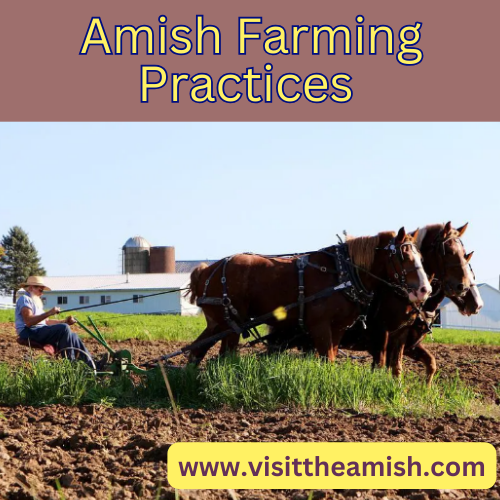The Amish have preserved traditional farming methods, emphasizing sustainability and a deep respect for the land. They believe that farming with horses and mules is a more humane way of raising crops, allowing the animals to play an active role in the process1. Amish farming is largely done with horse-drawn equipment, and they rely on traditional tools such as hand-held scythes and horse-drawn plows.
The Amish are fully committed to organic farming and use limited fertilizers, primarily relying on manure from livestock to nourish the soil. Their farms are typically smaller, less than 100 acres, and they make the most of their limited land with careful, regular seasonal plantings, crop rotation, and a reliance on livestock manure for fertilization1.

The main field crops grown by Amish farmers are typically wheat, corn, tobacco, hay, soybeans, barley, and fodder for livestock. They also have large vegetable gardens and sell the bounty from those parcels directly to local stores or through facilities like the Leola Produce Auction1. The Amish are considered to be good farmers, growing and storing the majority of their food and purchasing staples and other items in stores1.
The Amish farming and gardening secrets might not be easy, but they are effective, as they follow the seasons like clockwork to ensure the best planting and harvest times, obtaining the best results in the most natural way possible5.
The Amish have adapted to the changing times by developing new tools, equipment, and techniques to improve their bottom line without compromising their traditional farming methods4.The Amish farming methods are deeply rooted in tradition and a commitment to sustainability. They rely on organic farming practices, limited use of fertilizers, and traditional tools to cultivate their land and raise animals.

The use of horse-drawn equipment and a focus on seasonal plantings and crop rotation are key aspects of their farming practices. Despite the challenges posed by modernization and limited land availability, the Amish have maintained their agricultural heritage and continue to find success through their dedication to traditional farming methods.
The Amish approach to farming is characterized by a strong sense of community and a commitment to self-sufficiency. Amish farms are often family-owned and operated, with multiple generations working together to maintain the land and cultivate crops. This communal approach extends to the entire community, as neighbors often come together for events such as barn raisings and harvesting, fostering a strong sense of unity and cooperation.
One of the most distinctive features of Amish farming is the use of horse-drawn equipment. This practice is rooted in the Amish belief in simplicity and humility, as they seek to avoid the use of modern technology that may lead to pride and materialism. The Amish draft horses are well-trained and play a vital role in plowing fields, pulling wagons, and powering other farm machinery. This traditional method not only aligns with their religious beliefs but also minimizes the reliance on fossil fuels, reducing the environmental impact of their farming operations.
In addition to their focus on traditional tools and methods, the Amish are known for their sustainable approach to agriculture. They prioritize soil health and fertility, relying on natural fertilizers such as manure from their livestock. This practice not only reduces the need for chemical fertilizers but also helps maintain the balance of nutrients in the soil, promoting long-term sustainability.
Furthermore, the Amish are proponents of crop rotation, a practice that involves alternating the types of crops grown in a particular area from season to season. This technique helps prevent soil depletion and minimizes the risk of pests and diseases, contributing to the overall health of the farm’s ecosystem. By diversifying their crops and integrating livestock into their farming systems, the Amish are able to maintain a balanced and sustainable agricultural model.

The Amish also place a strong emphasis on preserving heirloom seeds and traditional plant varieties. They often save seeds from their own harvests, passing them down through generations. This practice not only helps maintain genetic diversity but also ensures that the crops are well-adapted to the local growing conditions, contributing to the resilience of their farming systems.
In conclusion, Amish farming practices are deeply rooted in tradition, sustainability, and community. By embracing organic methods, traditional tools, and a strong work ethic, the Amish have been able to maintain a unique agricultural heritage that stands in contrast to modern industrial farming. Their commitment to stewardship of the land and a harmonious relationship with nature serves as a valuable example of sustainable agriculture for the broader community.
The Amish farming methods offer important lessons in sustainability and resilience, highlighting the potential for traditional agricultural practices to coexist with modern advancements. By preserving their cultural heritage and passing down traditional knowledge, the Amish continue to inspire a deeper appreciation for the interconnectedness of farming, nature, and community.

